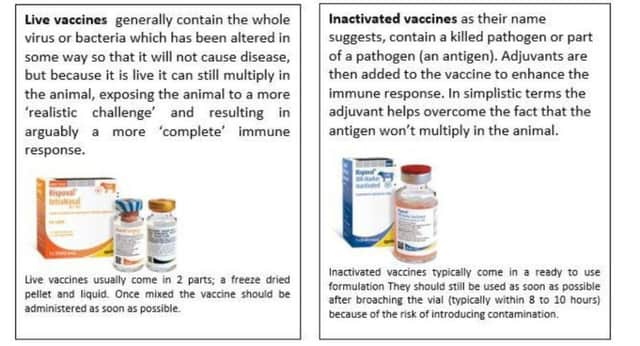Vaccines: what are they, how do they work, and how should you handle them


What are vaccines?
Vaccines are medicines which are designed to stimulate the immune system. Animals can be vaccinated against particular viruses, bacteria or parasites so that when they encounter these pathogens for real they are more able to fight off the infection. Vaccines can either be live or inactivated.
How do they work?


Vaccines work by exposing the animal’s immune system to the particular virus, bacteria or parasite in a safe way. This can have two functions.
Advertisement
Advertisement
1. Enhanced resistance to disease: The immune system of a vaccinated animal is primed to be able to neutralise the pathogen it has been vaccinated against more quickly. If the vaccinated animal comes into contact with any of the pathogens it has been vaccinated against in later life it is less likely to get sick.
2. Reducing viral and bacterial exposure: This element of how vaccines work is particularly important with respect to bovine respiratory disease (BRD). Sick infected animals will shed large quantities of viruses and bacteria (in secretions from the eyes and nose and in exhaled air), which can go on to infect neighbouring animals. Vaccination reduces both the number of sick animals and the amount of virus or bacteria shed by sick animals, so reducing the amount of virus and bacteria in the air and reducing the risk of neighbouring animals (both those in contact, and those sharing the same airspace) becoming infected.
Key Considerations For Youngstock Vaccine Selection


When selecting and undertaking any vaccination programme there are a number of things to consider. Using BRD as an example, a number of different vaccines are available which protect against one or more pathogens, it is therefore important that the right vaccine is selected based on the key priorities for your farm. Five things to consider;
1. Cover against the likely pathogens for the full risk period
Advertisement
Advertisement
Choose a vaccine that protects against the viruses/bacteria present on your farm for a sufficient period of time (e.g. the winter housing period).
2. Ensure protection is in place BEFORE challenge
For dairy/dairy-bred calves, late autumn/winter born suckler calves, and bought-in animals this can be difficult. Vaccines do not work immediately, for example BRD vaccines requiring a two dose course may not give protection until five-six weeks after the first dose. In these situations single dose vaccines, delivered via the intranasal route may be the most appropriate.
3. Vaccinate ALL youngstock in same airspace
Vaccination in many instances is a HERD/GROUP strategy (remember that the role of vaccination is two fold; increase immunity, and reduce pathogen shedding) - the best results are therefore gained from vaccinating the whole group within for example an airspace or management group. If an active decision has been taken not to vaccinate a particular group of calves, ideally these animals should be managed separately. In the case of BRD this means a separate airspace.
4. Age effect: passive immunity (from colostrum) can interfere with vaccination in young calves
Advertisement
Advertisement
Ensuring calves receive adequate colostrum is a vital part of overall calf management, but antibodies absorbed from this colostrum can prevent some vaccines from working. In the case of BRD use of intranasal vaccines can help to overcome this issue.
5. Avoid stress
Where possible avoid vaccinating at the same time as stressful procedures such as dehorning, castrating and weaning. The calf needs to ‘respond to’ the vaccine and stress can reduce its ability to do this, preventing the vaccine from working effectively.
Vaccine storage
Once an appropriate vaccine has been selected remember to store it correctly until needed. Most vaccines need to be stored in the fridge, at +2oC to +8oC until needed. Live vaccines are particularly sensitive to elevated temperatures, where inactivated vaccines are typically more sensitive to freezing. A recent study involving 19 farms in which the temperature inside the fridges used to store vaccines was monitored every 30 minutes between January and August 2014 found that ALL the fridges were outside the required temperature range on at least one occasion!
The minimum fridge temperature recorded was -12oC. Probably unsurprisingly, the fridge temperatures tended to exceed 8oC from May through to August, suggesting that the external temperature was affecting the ability of many farm fridges to maintain a low enough temperature. If you are investing in vaccines you want them to work, so before you purchase your vaccine make sure that your fridge is in good working order!
Handling Vaccines On-Farm
Advertisement
Advertisement
Good practice in terms of handling of vaccines on-farm is critical in ensuring we achieve maximum benefit from any vaccination programme. Key points include:
Maintain the cold chain – from purchase to administration. Most vaccines need to be stored in the fridge prior to use, so it’s important your fridge is up to the job, but also that you get the vaccine into your fridge as soon as possible after purchase. That means stopping off at the mart for breakfast whilst the vaccine you just purchased sits cooking in the landrover is best avoided!
Use the vaccine exactly according to the product insert (you’ll find this inside the vaccine box) - check the dose, route, expiry and storage requirements.
Where possible avoid concurrent treatments or unlicensed vaccinations, but this should be discussed with your vet since these decisions will be based around a risk-benefit assessment for your individual farm.
Advertisement
Advertisement
Ensure automatic injection equipment is calibrated correctly.
Clean syringes and needles should be used – this goes for all medicines but is particularly important when administering vaccines. Chemically sterilised syringes should not be used with live vaccines.
Live vaccines should be administered to the animal as soon as mixed - live vaccines usually come as two vials, one vial containing a freeze dried pellet or plug containing the live antigen, and a vial containing liquid for mixing – this may or may not contain active components. The vaccine should be given immediately or within two hours of mixing to avoid deterioration of the live antigen(s).
Sick animals should not be vaccinated - many vaccine programmes are given on a herd/group level so if you are unsure whether or not to vaccinate certain animals ask your vet. Some vaccines, for example against IBR, are licensed to be used in the face of a disease outbreak, again this will be under veterinary direction, so decisions on whether or not certain animals should be vaccinated should be discussed.
Advertisement
Advertisement
Mark animals once vaccinated so none are missed or vaccinated twice!
Discard part used vials of vaccine at the end of the day - this applies to all vaccines, including inactivated and ready-to-use vaccines because of the risk of introducing contamination into the vaccine bottles.
Record animal ID, the date and vaccine used in your medicine book.